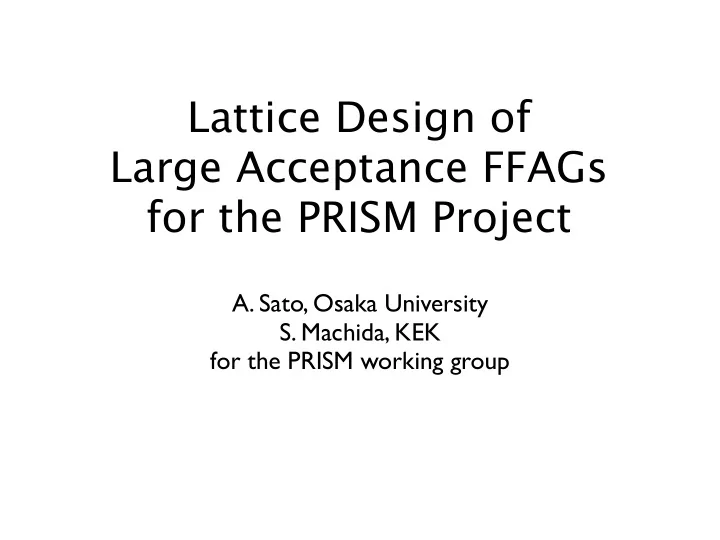

Lattice Design of Large Acceptance FFAGs for the PRISM Project A. Sato, Osaka University S. Machida, KEK for the PRISM working group
Requirements for the PRISM-FFAG Large Transverse Acceptance To realize a high intensity muon beam, an enormous transverse acceptance is important. horizontal acceptance > 20000 pi mm mrad vertical acceptance > 3000 pi mm mrad Long Straight section Since the muon is an unstable particle (life time~2.2us), it is crucial to complete phase rotation as quickly as possible in order to increase a number of surviving muons. In present design, PRISM requires very high field gradient of 200kV/m at the low frequency (4-5 MHz). in order to locate the ultra-high field gradient RF cavities, FFAG has to have long straight sections as many as possible. super muon source = PRISM
3D tracking by geant3.21 quasi-3D mag. field Lattice Design In order to achieve a high intensity muon beam, it is necessary for the PRISM-FFAG parameters : to have both of large transverse number of cell acceptance and large momentum acceptance. Furthermore, long straight FD,DFD,FDF sections to install RF cavities are required k value to obtain a high surviving ratio of the muon. Therefore, the PRISM-FFAG F/D ratio requires its magnets to have large gap size aperture and small opening angle. In such magnets, not only nonlinear effects but also fringing magnetic field are important to study the beam dynamics of FFAGs. Three-dimensional tracking is adopted to study the dynamics of FFAG from the to study : beginning of the lattice design procedure. In this process, quasi-realistic 3D acceptance (H,V) magnetic field maps, which are calculated tune applying spline interpolation to POISSON 2D field, were used instead of TOSCA tune shift field in order to estimate the optical beam size etc property quickly
How to make quasi-realistic 3D magnetic fields step 1 : calculate magnetic field step 2 : convert the field (B θ ,Bz) to (Bx(~B θ ) ,Bz) of each z- θ cross (Bz,B θ ,Br) by using Maxwell eq. sections (r1-r5). x-axis is considered as θ - axis (approximation). B z ( z i ) = B y ( z i ) B θ ( z i ) = B x ( z i ) r5 B r ( z i ) = dB z r4 ( Z i − Z i − 1 ) + B r ( Z i − 1 ) dr r3 ( Z i ) r2 step 3 : to make a fine mesh field r1 r map, apply a 2D spline x ( θ ) interpolation to the above field map.
quasi-3D quasi-3D Comparison b/w TOSCA and quasi-3D tracking results TOSCA TOSCA N=8 k=5 F/D = 7.1 r0=5m
Acceptance Study DFD, N=10, half gap=15cm, w/o field clamps, r0=6.5m for 68MeV/c Horizontal phase spaces are plotted Vertical phase spaces are plotted in in a tune diagram. a tune diagram.
5cm 10cm 15cm 20cm Acceptance dependence on gap size of magnets DFD, N=10, w/o field clamps, r0=6.5m for 68MeV/c
140000πmm mrad 3000πmm mrad 35000πmm mrad Tracking results N=10, F/D=8, k=5, r0=6.5m horizontal vertical An effective horizontal acceptance is 35000 pi mm mrad in consideration of correlation between horizontal and vertical acceptance
Recommend
More recommend